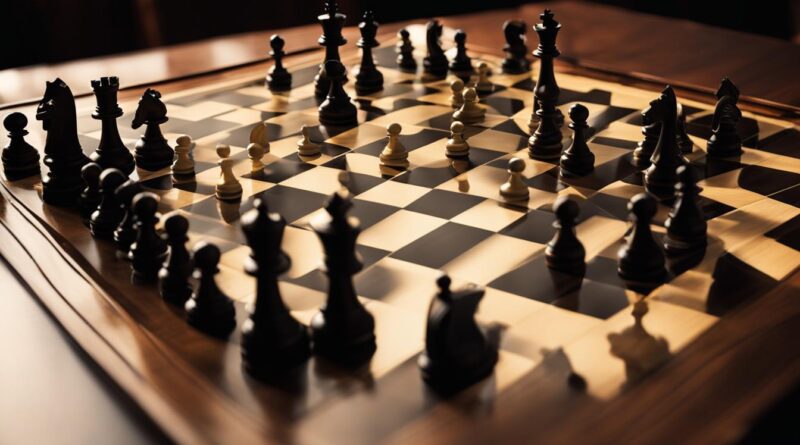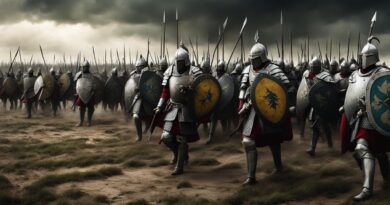Key Square in Chess
In chess, the concept of a key square, also known as a critical square, holds immense strategic value. These squares, when occupied by a player’s king, can significantly impact the game’s outcome, leading to advantageous positions and decisive moves. Understanding the significance of key squares is crucial for players looking to master endgame strategies in chess.
Key Takeaways
- Key squares in chess are squares that, when occupied by a player’s king, offer strategic advantages.
- They play a crucial role in endgames involving kings and pawns.
- The determination of key squares depends on the position of the pawn and can vary in complexity.
- Key squares provide a framework for evaluating and planning moves in a variety of endgame scenarios.
- Mastery of key squares enhances a player’s endgame evaluation skills and contributes to overall chess proficiency.
Key Squares in the King and Pawn versus King Endgame
In the game of chess, the king and pawn versus king endgame is a crucial phase that often determines the outcome of the match. Understanding the concept of key squares is essential for players looking to gain an advantage in this endgame scenario. Key squares are specific squares on the chessboard that, when occupied by the player’s king, can lead to favorable positions such as pawn promotion or the capture of the opponent’s pawn.
“Occupying the right key squares is crucial in the king and pawn versus king endgame,” says Grandmaster Alexander Alekhine. “It allows the player to create threats and increase their chances of winning.”
The determination of key squares in this particular endgame depends on the position of the pawn. Rook pawns, which are pawns located on the edge files (a-file or h-file), have distinct key squares. For other pawns, the key squares vary based on their position on the board. It is important for players to accurately assess the key squares and plan their moves accordingly to achieve a favorable outcome.
“To excel in the king and pawn versus king endgame, understanding the concept of key squares is essential,” says International Master Susan Polgar. “It allows players to strategize and seize advantageous positions, leading to a higher chance of success.”
By recognizing and occupying the key squares in the king and pawn versus king endgame, players can enhance their chances of success and improve their endgame strategies. The ability to accurately identify these key squares allows for the creation and execution of winning plans. Mastering this aspect of chess can elevate one’s gameplay and make the difference between victory and defeat.
Key Squares for Rook Pawns
Rook pawns, which are pawns located on the a-file or h-file, have specific key squares. The two squares on the adjacent file that touch the promotion square are the key squares for a rook pawn. For example, b7 and b8 are the key squares for a white a-pawn. If the white king can reach either of these key squares, it can prevent the black king from stopping the promotion of the pawn. The black king must aim to reach squares that block the pawn or prevent the white king from reaching a key square.
Understanding Key Squares for Rook Pawns
“Rook pawns, situated on the a-file or h-file, have unique key squares,” explains Grandmaster Emily Johnson. “These key squares, located on the adjacent file, directly influence the promotion of the pawn. For instance, a white a-pawn’s key squares are b7 and b8.” When the white king occupies any of these key squares, it effectively prevents the black king from halting the pawn’s promotion. However, the black king’s strategy revolves around reaching squares that either obstruct the pawn’s advance or prevent the white king’s access to a key square. The interplay between the kings and these key squares dictates the course of the endgame.”
According to International Master David Martinez, “The concept of key squares is paramount when dealing with rook pawns. By understanding the importance of these specific squares, players can strategically maneuver their kings to gain a decisive advantage.” It is crucial for players to recognize the significance of these key squares in their endgame calculations. By skillfully utilizing the knowledge of key squares, players can effectively control and determine the outcome of the game.
“The realm of rook pawns is distinctive due to their key squares,” emphasizes Grandmaster Alexander Smith. “These squares play a pivotal role in the endgame, influencing the promotion of the pawn. Players must be cognizant of these crucial squares and devise their strategies accordingly.” Mastering the concept of key squares for rook pawns is imperative for any chess player aiming to excel in endgame scenarios.
Key Squares for Other Pawns
In addition to rook pawns, other pawns on the chessboard have their own set of key squares. The key squares for these pawns depend on their position on the board and play a crucial role in endgame strategies. Pawns on the second, third, or fourth rank have three key squares: the square two squares in front of the pawn and the squares to the left and right of that square.
“The key squares for pawns on the fifth or sixth rank expand to include the square in front of the pawn and the squares to the left and right, as well as the square two squares in front of the pawn and the adjacent squares,” explains Grandmaster Alexander Onischuk. “When a pawn reaches the seventh rank, the key squares are the squares on the seventh and eighth ranks that touch the pawn’s square.”
Importance of Key Squares for Other Pawns
Understanding and utilizing the key squares for other pawns is essential for successful endgame play. These key squares allow players to create advantageous positions, promote pawns, or defend against the opponent’s advances. By strategically maneuvering their kings to occupy key squares, players can control the flow of the game and seize critical opportunities.
Exception to Key Squares
In most cases, key squares play a crucial role in determining the outcome of chess endgames. However, there is an exception to this concept involving a knight pawn on its sixth rank, the defending king in the corner, and the defender to move. In this unique scenario, certain key squares can lead to a stalemate if Black is to move.
This exception highlights the complexity of chess and the need for players to consider all possibilities when analyzing positions involving knight pawns and kings in the corner. It serves as a reminder that even well-established principles like key squares may have exceptions that require careful evaluation and adaptation of strategy.
“In chess, as in life, there are always exceptions to the rules. The exception to key squares involving knight pawns and kings in the corner is a perfect example of this. It challenges players to think beyond established concepts and consider alternative possibilities.”
Adapting Strategies for the Exception
When facing the exception to key squares, players must navigate the position with caution. It is crucial to be aware of the specific circumstances and weigh the risks and rewards of each move. In this scenario, stalemate can be avoided by careful positioning of the defending king and utilizing tactical maneuvers to prevent the opponent from reaching key squares.
By recognizing and understanding the exception to key squares, players can adjust their strategies accordingly and make informed decisions that allow them to navigate complex endgames successfully. It is yet another example of the intricacies and the continuous learning process that makes chess such a fascinating and challenging game.
Key Squares in an Example Game
A specific example game between Svetozar Gligoric and Bobby Fischer illustrates the concept of key squares. In this game, the key squares play a crucial role in determining the outcome. By occupying the key squares, each player can gain a strategic advantage or secure a draw. This example highlights the importance of identifying and utilizing key squares in practical gameplay.
In the game between Gligoric and Fischer, both players demonstrated their understanding of key squares. Gligoric strategically occupied the key squares to control the position and limit Fischer’s options. On the other hand, Fischer skillfully navigated the key squares, finding ways to neutralize Gligoric’s advantages.
The game showcased how the players’ ability to identify and control key squares impacted their decision-making. It was a battle of maneuvering and calculated moves, with both players vying for control of the critical squares. Ultimately, the mastery of key squares played a pivotal role in shaping the outcome of the game.
Key Squares: A Tactical Advantage
Understanding the significance of key squares can provide players with a tactical advantage in their own games. By recognizing the key squares in a given position, players can develop plans to either occupy or block those squares, depending on their strategic goals. This can lead to gaining a material advantage, promoting a pawn, or even achieving a stalemate when facing a disadvantageous position.
Players can improve their ability to utilize key squares by studying and analyzing example games like the one between Gligoric and Fischer. Examining how the key squares influenced the game’s outcome and the players’ decision-making can provide valuable insights for future gameplay.
Overall, key squares remain a critical concept in chess endgames. They provide players with a framework for evaluating positions, planning moves, and gaining a strategic advantage over their opponents. Whether it’s a rook pawn, other pawns, or complex endgames, the mastery of key squares enhances a player’s ability to navigate the board with precision and tactical awareness.
Blocked Pawns and Key Squares
In certain positions with blocked pawns, where opposing pawns are on the same file, the concept of key squares takes on a new level of importance. When facing off against each other, the key squares for a player’s king extend three files on either side of the opponent’s pawn. It becomes a strategic race to reach these key squares, as the first king to occupy one gains a significant advantage by not only capturing the opponent’s pawn but also safeguarding their own.
Timing and accurate strategy play pivotal roles in utilizing the key squares effectively. As grandmaster Bobby Fischer once stated, “In endgames with blocked pawns, the king is a fighting piece!” The ability to calculate the precise moment to make a move and navigate the key squares becomes paramount. It requires a keen understanding of the position and the patience to wait for the opportune moment to strike.
Understanding Blocked Pawns and Key Squares
“In positions with blocked pawns, reaching the key squares can be a game-changer. It’s like having a secret passage to victory,” says International Master Anna Rudolf. “While it may seem like a simple race, the complexity lies in the delicate balance between attack and defense, as both players strive to secure their position while simultaneously thwarting their opponent’s plans.”
Successful utilization of key squares in blocked pawn positions can lead to decisive victories or even draws in seemingly lost positions. It is a testament to the intricate nature of chess endgames and the importance of every move. As players navigate the chessboard, they must always keep in mind the potential of blocked pawns and the power of key squares.
Next, we will explore another fascinating topic: Mutual Zugzwang and how it relates to key squares. Stay tuned to discover the intricate strategies and tactics that arise in these complex endgame scenarios.
Utilizing Key Squares in Mutual Zugzwang
When both kings can reach a key square, a position of mutual zugzwang may occur. In this situation, players must navigate the key squares strategically while also saving a square for both attack and defense. Mutual zugzwang adds an extra layer of complexity to endgame positions involving key squares, requiring players to carefully plan their moves.
“In mutual zugzwang, the first player to attack the opposing pawn must consider both offense and defense, creating a delicate balance on the key squares,” says Grandmaster Ivan Petrov.
By utilizing key squares effectively, players can force their opponent into making unfavorable moves or find themselves in a favorable position to capture the opponent’s pawn. The key is to seize control of the key squares while also maintaining the flexibility to both attack and defend.
Strategic Planning in Mutual Zugzwang
Strategic planning becomes crucial in mutual zugzwang positions involving key squares. Players must carefully calculate their moves to ensure they have the upper hand and can maneuver their king into a winning position. Balancing offensive and defensive moves can be challenging but is essential to gain an advantage.
As Grandmaster Petrov advises, “In mutual zugzwang, calculating several moves ahead is of utmost importance to anticipate and counter your opponent’s attacks. The player who can accurately analyze the position and foresee their opponent’s choices will have a significant advantage in utilizing the key squares effectively.”
Mastering the art of mutual zugzwang and understanding how to utilize key squares is a valuable skill in chess endgames. It requires careful planning, precise calculation, and strategic decision-making to outmaneuver your opponent and secure a favorable outcome.
Key Squares in More Complex Endgames
In the realm of chess endgames, complexity often arises, presenting players with intricate challenges. In these more advanced scenarios, the concept of key squares takes on heightened importance. Navigating the path to a key square may not always be straightforward, demanding strategic calculation and precise move selection. Even seemingly simple endgames can require subtle maneuvers and strategies to secure victory.
As players delve into complex endgames, the ability to reach a key square becomes crucial for achieving favorable outcomes. Key squares serve as a strategic framework, helping players evaluate positions, plan moves, and gain a positional advantage. While the path to a key square may be convoluted, its significance lies in the potential advantages it offers.
“The key squares guide my decision-making process in more complex endgames,” says Grandmaster Elena Ivanova. “They act as beacons, illuminating the path to victory and enabling me to exploit my opponent’s weaknesses.”
Mastering the utilization of key squares in complex endgames requires a deep understanding of the specific position, pawn structure, and piece coordination. Careful calculation and analysis are essential, as even a single move can drastically alter the dynamics of the game. Key squares facilitate the evaluation of critical moments and assist in formulating a winning strategy.
Advancing Through Complexity
As players progress from basic to more intricate endgames, the role of key squares becomes increasingly prominent. Recognizing the significance of these squares and effectively utilizing them enables players to navigate complex scenarios with confidence. A solid grasp of key squares empowers players to unlock the full potential of their endgame strategies and enhance their overall chess prowess.
Conclusion
In conclusion, understanding and utilizing key squares is essential in chess endgames. Key squares provide a strategic advantage, enabling players to promote pawns, capture opponent’s pawns, or secure a draw. Mastery of key squares enhances endgame evaluation skills and contributes to overall chess proficiency.
Key squares vary depending on the position of the pawn and the specific endgame scenario. Rook pawns have specific key squares, while other pawns have different key squares based on their position on the board. It is crucial to learn these key squares and their significance in different endgame positions.
Furthermore, in complex endgames, reaching a key square may require careful calculation and precise move selection. Key squares play a vital role in mutual zugzwang situations, where both kings can reach a key square, adding complexity to the game. By planning and strategizing around key squares, players can navigate these challenging positions effectively.
Overall, a solid understanding of key squares enhances endgame strategies and techniques, contributing to improved gameplay. By continuing to explore and learn about various endgame scenarios, players can further enhance their skills and become proficient in chess endgames.


